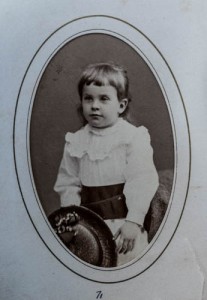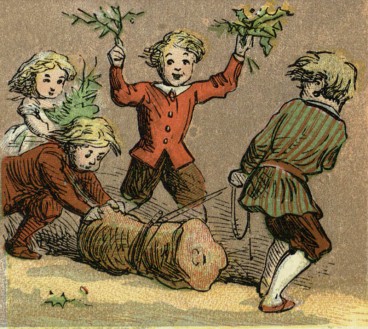
Evelina Orville Gilmore Ames
(1809 – 1882)
Thursday Dec 31st This the last day of the year
and the last that I shall write in this
book Mrs Witherell Emily Mrs Ames
& Oliver & wife dined here & spent the
afternoon father is not well and did
not come This evening we have all
been to the lecture at the meeting house
Mr Pierpont recited a poem The Scholars hope
and it was very fine We have a box from Burlington
filled with presents I had a basket
of moss in a leather frame from Mrs
Mills & a ribbon from cousin Harriet
Susan an emery and she is disappointed
says they always send an emery
Thus ends the second year
that I have written in this book of nonsense
This is the last day of Evelina’s diary, and aren’t we sorry! No more sifting through the pages and peeking through the keyhole at the domestic life of the Ames family in the 1850’s. Although we know that Evelina kept other diaries in other years, specifically during the 1860’s, we don’t know if she wrote steadily. No other diaries by her are extant.
We do know something about the remaining trajectory of Evelina’s life, however. After she closed the cover on her so-called “book of nonsense,” she lived another thirty years. By the end of the 1850’s, her sons Oakes Angier and Frank Morton had married and begun to have children (see below). Frank would move to Canton (and Boston) but would stay in close contact with his brothers, who stayed in North Easton. Middle son Oliver (3), the last of her sons to leave home, would marry in the spring of 1860, build a home nearby (since razed) and raise a large family. Daughter Susan would marry wool merchant Henry W. French in January 1861, but the couple would have no issue. That must have been a disappointment to them and to Evelina.
Over the years left to them, Evelina and Oakes would enjoy the arrival of and periodic proximity to 19 grandchildren (three of whom would not survive childhood). In birth order, those grandchildren were:

Maria Hobart Ames (Mrs. Richard Hickman Harte, 1856 – 1918), first daughter of Oakes Angier and Catharine Hobart Ames

Frank Angier Ames (1857 – 1918), first son of Frank Morton and Catherine Copeland Ames
No image available
Oakes Ames (1858 – 1859), first son of Oakes Angier and Catharine Hobart Ames

Alice Lurana Ames (Mrs. Edward Crosby Morris, Mrs. George Frederick Chapman, 1859 – 1934), first daughter of Frank Morton and Catherine Copeland Ames
No image available
Oakes Angier Ames (1861 – 1862), second son of Oakes Angier and Catharine Hobart Ames

Charles Oakes Ames (1861 – 1864), second son of Frank Morton and Catherine Copeland Ames

William Hadwen Ames (1861 – 1918), first son of Oliver Third and Anna C. Ray Ames

Oakes Ames (1863 – 1914), third son of Frank Morton and Catherine Copeland Ames

Evelina Orville Ames (Mrs. Frederick Garrison Hall, 1863 – 1940), first daughter of Oliver Third and Anna C. Ray Ames
No image available
Anna Lee Ames (Mrs. George Manning Nowell, 1864 – 1934), second daughter of Oliver Third and Anna C. Ray Ames

Hobart Ames (1865 – 1945), third son of Oakes Angier and Catharine Hobart Ames
No image available
Susan Evelyn Ames (Mrs. Thomas Taylor, 1867 – 1949), third daughter of Oliver Third and Anna C. Ray Ames

Lilian Ames (Mrs. Harry Lorenzo Chapman, 1870 – 1925), fourth daughter of Oliver Third and Anna C. Ray Ames

Winthrop Ames (1870 – 1937), fourth son of Oakes Angier and Catharine Hobart Ames

Anna Copeland Ames (Mrs. George Edward Hall, 1870 – 1908), second daughter of Frank Morton and Catherine Copeland Ames

Katie Evelyn Ames (Mrs. Frederick Page Royce, 1872 – 1944), third daughter of Frank Morton and Catherine Copeland Ames

Harriet Elizabeth Ames (Mrs. George Edward Hall, 1873 – 1948), fourth daughter of Frank Morton and Catherine Copeland Ames

Katharine “Kitty” Hobart Ames (Mrs. Philip Leffingwell Spalding, 1874 – 1949), second daughter of Oakes Angier and Catharine Hobart Ames

Oakes Ames (1874 – 1950), second son of Oliver Third and Anna C. Ray Ames^
In 1863, Oakes Ames was elected to the U.S. Congress as Representative for Massachusetts Second District. He would serve five consecutive terms, much of it effectively and actively, being especially involved in the building of the transcontinental railroad. He served during the critical era of the Civil War and the ensuing Reconstruction, and voted in favor of the thirteenth, fourteenth and fifteenth amendments. He lived much of the time in Washington, D.C. in modest quarters. Evelina also spent at least some of her time with him, keeping house and attending appropriate social functions. During her time in the capitol, she would have gone to the White House for at least some of the many receptions there, and met the Lincolns, the Andrew Johnsons, and perhaps the Grants. When her brother-in-law Oliver Jr visited, as he had occasion to do on railroad business, they would attend church together.
Yet Evelina also maintained the family residence in North Easton, which Susan and Henry French moved into on an undetermined date. Matters changed when, in 1870, Evelina suffered a stroke while in Washington. She was partially paralyzed, and in July of that year Oakes brought her back home on the train where her brother-in-law noted that Evelina “has had a Paralytic Shock which has crippled her very much walking with great difficulty.”**
Trouble with paralysis would hinder Evelina’s mobility for the remainder of her days, and probably prevented her returning to Washington for the remainder of Oakes’s service there. She wasn’t with him when he went through the great difficulties spawned by his work on the Union Pacific and the ensuing Credit Mobilier scandal. The two corresponded, however, and one intimate letter from Oakes to Evelina was saved. On January 18, 1873, he wrote:
Dear Wife:
I sent you a telegram today that all will come out right. Don’t feel uneasy on my account, as there will be no stain on my reputation, whatever others may do. Am sorry that you feel so badly. Remember the scriptures say that “whom the Lord loveth he chasteneth.” You must see by that passage that I am in high favor in the right quarter. The committee are in session this evening, and I must close. Good night! Borrow no trouble on my account. My health is good. – Yours, Oakes***
Family lore has it that Evelina waited for the arrival of that telegram – and others, possibly – by sitting at the window in her corner bedroom watching out for the telegraph boy. When Oakes finally returned to North Easton for good in February 1873, he only lived for a few more months.

After Oakes died, Evelina continued to live in the old family house, built by Old Oliver back in the day, and made additional, modernizing improvements to it. Sarah and Emily Witherell had departed their part of the house some years earlier and were living at the Hotel Hamilton in Boston, but daughter Susan and her husband Henry lived in the house with her. Evelina continued to see all her children and grandchildren, giving and receiving gifts on birthdays and (finally won over to the holiday) at Christmas. Her health declined, however.
The very last we hear of Evelina is via a memory of her youngest grandchild, botanist Oakes Ames:
I remember my grandmother (paternal) in connection with a birthday afternoon when I was led, half afraid, to the driveway end of our verandah to receive from her hand a box of peppermints and a silver dollar. My grandmother died when I was eight years old. As I see her now in my mind’s eye, she was very much like her portrait. I am sure that at this time, except for a white cap and a white lace at her wrists and throat, she wore no other color than black.***
That Evelina suffered ill health in the decade-plus after her stroke is underscored by her grandson’s second memory of her:
I have only two mental pictures of my grandmother. One, when she was in her phaeton and handed to me my birthday gift. The other when she was in the large livingroom at Martha’s Vineyard where we used to spend the summers. At this time she was in her rocking chair stamping her feet violently on the floor. She was suffering from a nervous tantrum or from pain, I know not which, but I remember being hastily removed from the room by one of my elders. All this must have been before I was eight years old.****
On July 20, 1882, Evelina died at home of “paralysis.” She was buried in the Village Cemetery next to her husband.
*Genealogy of the Ames Family of North Easton, Massachusetts, ed. Chilton Moseley Ames and William Motley Ames, 1998
**Oliver Ames, Jr., Journal, July 17, 1870, Private collection.
***Ames Papers, Frank Morton Ames scrapbook, Baker Library, Harvard University
****Oakes Ames: Jottings of a Harvard Botanist, ed. Pauline Ames Plimpton, Cambridge, 1979, pp. 37-38
^Photographs of grandchildren courtesy of Stonehill College Archives


























